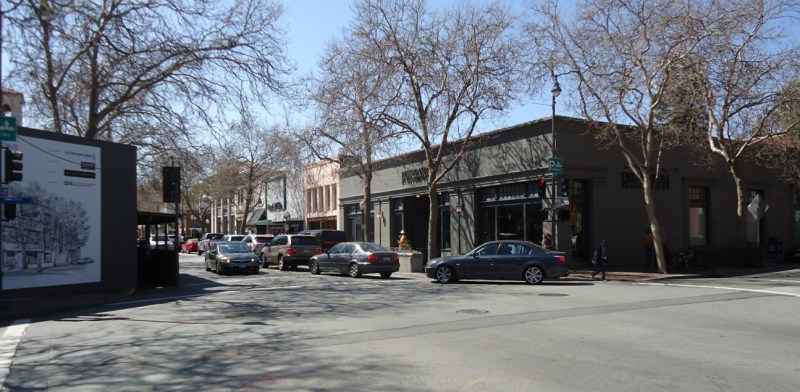Whenever one moves to a new place, there emerges the unavoidable human need to compare. We tend to make ourselves crazy, imagining the non-existent ideal place where all of our favorite things coexist. Living in the U.S. for four years now and being in a stable relationship with a San Jose local, I can confidently say that I have gotten accustomed to the American way of life. This manifests in so much that when I visit home, I perceive local customs as out of the ordinary.
That same feeling of estrangement struck me the other evening as I was in grave need of a long walk around Palo Alto. This urge came after a long self-imposed lockdown due to the persistently bad air quality that kept hitting our beloved California and beyond. To my greatest surprise, University, Ramona and Emerson Avenues seemed different than usual and flushed me with a cozy taste of home.
A short digression into my personal life — I’m from Croatia, praised for its historic and natural beauty, but I spent most of my twenties studying in Austria, Germany and France, each with a unique cultural heritage. Despite their differences, all of these countries share a rather similar approach to socializing in public spaces that stands in stark contrast to my experiences in the United States.
Whether these customs got enhanced by Europe’s dependence on tourism or it was always this way, it is hard to say, but for as long as I can remember, Europe’s public spaces have been flooded with tables and chairs, seamlessly connecting a line-up of bars and restaurants. In their attempt to lure a special kind of crowd, each establishment carefully crafts a set of parasols, fences, decorations, flowers, or even trees and bushes, hoping to give their place the right ambiance. Heading to work in the morning, one might get irritated as one squeezes past a bar terrace that barely leaves a catwalk to pass by. Yet once your workday has ended, it is equally enjoyable to sip a drink at that very same terrace with a friend. And if you want to avoid bars, you can get some drinks from the supermarket and enjoy them, sitting on a public lawn, bench or park, as long as you are not misbehaving or disturbing the neighborhood. This certainly makes the contrast to social life in the States even more evident.
First, American open-container laws mostly limit alcohol outdoor consumption to private residences or registered establishments. As a result, most outdoor seating will be situated in private gardens, backyards, back alleys or, in rare cases directly on the street, as a single row of enclosed tables. Second, the wide streets and more grid-like city plans leave little room for snug, narrow and winding pedestrian streets. Third, people here tend to use cars much more, so there is less spontaneous walking around. Since most streets allow for street parking, a typical layout that consists of a walkway-line of parked cars and a two-way road does not really feel socially inviting. It is almost as if the street wants to say that its sole purpose is to provide a way through. Furthermore, the absence of squares that are not parks (at least that is how Europeans think of them), adds on to this impression of public space being simply a necessary binding element between multiple private properties (be it homes, workspaces, shops or bars) whose potential for social interaction is left unexplored.
However, as I walked through Palo Alto, there was a perfume of Europe in the air. The necessity to survive in times of pandemic and strict epidemiological restrictions made food and beverage venues think creatively. And creative they were, by simply moving outdoors. Now, something unimaginable even half a year ago suddenly became the new normal. Streets that used to look gray and uninviting turned into a florid suite of outdoor terraces occupying parking lots, parts of sidewalks or even entire streets. Carefully designed wooden fences, charming flowers in colorful pots, olive trees, small fire pits, patio heaters with nice soft lighting and other decoration filled the streets of Palo Alto. One could even take a glass of alcoholic beverage to go and enjoy this atmosphere outside, as long as one stayed within these newly designated pedestrian areas, which is exactly what I did. For a moment I forgot where I was, overwhelmed by a warm and fuzzy feeling of nostalgia. I looked around at this reinvigorated Palo Alto, radiating with the charm of a picturesque European town. In the following days, as errands led me to drive through Menlo Park and Redwood City, I noticed the exact same transformation all over the Bay area.
The fact that this trend reminds me of Europe aside, what I loved about it was to see how COVID-19, despite all of the disruption it caused, also inspired new ways for Californians to come together.
It showed the resilience of the American spirit as well as its capacity to change and adapt for the better. Will this trend still be around once the pandemic is over? Who knows! One can only long for more positive metamorphoses coming out of the struggles that we are all facing in one way or another, rather than succumbing to bitterness. Especially during these precarious and politically tumultuous times, an example like this gives hope that America has the potential to reshape itself into a place that everyone can call home.
Contact Davor Vince at vincze ‘at’ stanford.edu.
